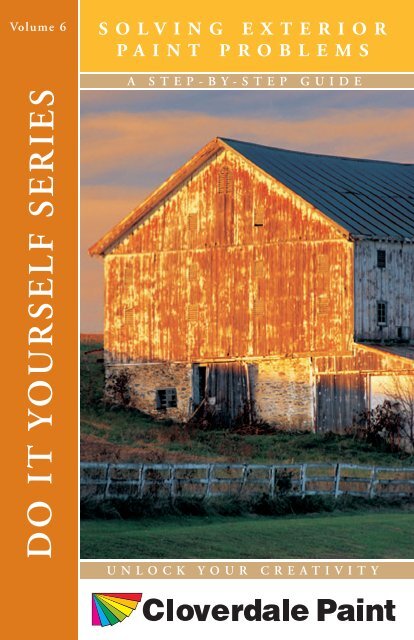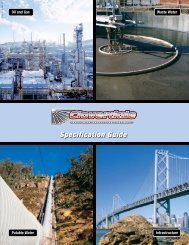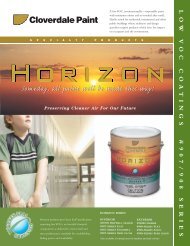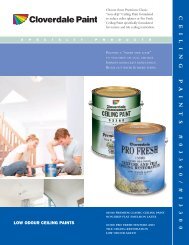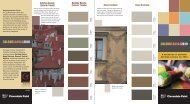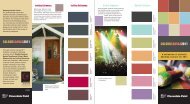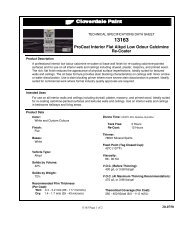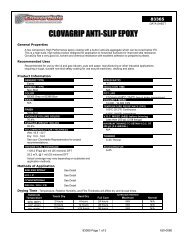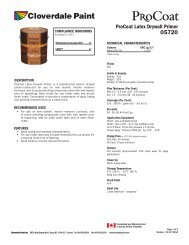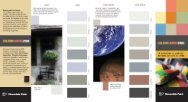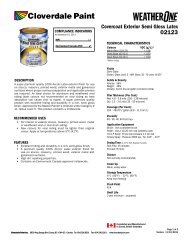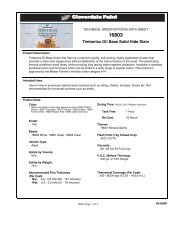DO IT Y OURSELF SERIES - Cloverdale Paint
DO IT Y OURSELF SERIES - Cloverdale Paint
DO IT Y OURSELF SERIES - Cloverdale Paint
You also want an ePaper? Increase the reach of your titles
YUMPU automatically turns print PDFs into web optimized ePapers that Google loves.
Volume 6<br />
<strong>DO</strong> <strong>IT</strong> Y<strong>OURSELF</strong> <strong>SERIES</strong><br />
SOLVING EXTERIOR<br />
PAINT PROBLEMS<br />
A STEP-BY-STEP GUIDE<br />
UNLOCK YOUR CREATIV<strong>IT</strong>Y
<strong>DO</strong> <strong>IT</strong> Y<strong>OURSELF</strong> <strong>SERIES</strong><br />
STEP-BY-STEP GUIDES<br />
Volume 1 . . . . . . . . . . . . . . . . . . . . . .<br />
Exterior <strong>Paint</strong>ing<br />
Volume 2 . . . . . . . . . . . . . . . . . . . . . .<br />
Interior <strong>Paint</strong>ing<br />
Volume 3 . . . . . . . . . . . . . . . . . . . . . . . .<br />
Brush & Roller<br />
Volume 4 . . . . . . . . . . . . . . . . . . . .<br />
Decorative Finishes<br />
Volume 5 . . . . . . . . . . . . . . . .<br />
Interior Wood Finishing<br />
Volume 6 . . . . . . . . . .<br />
Solving Exterior <strong>Paint</strong> Problems<br />
Volume 7 . . . . . . . . . . . . . . . . . . . . . . . .<br />
Wallcoverings<br />
UNLOCK YOUR CREATIV<strong>IT</strong>Y<br />
For all of your home decorating and improvement needs,<br />
our trained and knowledgeable staff can help with your questions.
Volume 6<br />
SOLVING EXTERIOR<br />
PAINT PROBLEMS<br />
A STEP-BY-STEP GUIDE<br />
Peeling Solutions:<br />
If exterior moisture is<br />
the cause, eliminate the<br />
source by taking such<br />
steps as repairing the<br />
roof, replacing caulking,<br />
and cleaning gutters<br />
and downspouts; also,<br />
cut vegetation away<br />
from the building. If<br />
moist air is originating<br />
inside the building,<br />
consider installing<br />
vents, especially in<br />
kitchen, bathroom and<br />
laundry areas; attic<br />
louvers, exhaust fans<br />
and dehumidifiers<br />
may also be helpful.<br />
Remove all loose paint<br />
with a scraper or wire<br />
brush, sand rough<br />
surfaces and prime any<br />
bare wood that is<br />
visible. Repaint with<br />
our top quality acrylic<br />
latex paint. This will<br />
provide excellent<br />
adhesion and allow<br />
water vapor to escape<br />
without harming the<br />
coating.<br />
Solving Exterior <strong>Paint</strong> Problems<br />
Adhesion is one of the most important<br />
characteristics of exterior paint. In fact, many of<br />
the most common paint problems are due to<br />
adhesion failures.<br />
To correct an adhesion problem, it is important to<br />
first understand why the failure occurred, then<br />
proper steps can be taken to prevent reoccurrence.<br />
Keep one thing in mind, however: Top quality paints,<br />
especially those made with acrylic binders, have<br />
better adhesion properties than standard grades of<br />
paint. So, it is always wise to repaint with a top<br />
quality coating.<br />
This guide provides more specific information on<br />
common paint problems and suggestions on how to<br />
correct them.<br />
Peeling<br />
The spontaneous loss of ribbons or sheets of paint<br />
due to loss of adhesion. When the surface is coated<br />
with a primer and topcoat, or with several coats of<br />
paint, the peeling may involve all the coats, some of<br />
them, or just the topcoat.<br />
Possible Causes<br />
Swelling of wood due to seepage or penetration of<br />
rain, humidity and other forms of moisture into the<br />
home through uncaulked joints, deteriorated caulk,<br />
a leaking roof or other areas.<br />
UNLOCK YOUR CREATIV<strong>IT</strong>Y<br />
For more information about our products, visit us on the web at<br />
www.cloverdalepaint.com
Volume 6<br />
SOLVING EXTERIOR<br />
PAINT PROBLEMS<br />
A STEP-BY-STEP GUIDE<br />
Chalking Solutions:<br />
First, remove as much<br />
of the chalk residue as<br />
possible, using a stiff<br />
bristle brush (or wire<br />
brush on masonry) and<br />
garden hose; to speed<br />
the work, consider<br />
using power washing<br />
equipment. Allow the<br />
surface to dry, then<br />
check for any remaining<br />
chalk by running a<br />
hand over the surface.<br />
If some chalk is still<br />
present, apply a quality<br />
oil-based or acrylic<br />
latex primer (or comparable<br />
sealer for<br />
masonry), then repaint;<br />
if little or no chalk<br />
remains, simply repaint.<br />
Finally, if chalk rundown<br />
has discolored brick,<br />
masonry or another<br />
surface, try removing<br />
the stains by scrubbing<br />
the areas with a stiff<br />
brush and detergent<br />
solution and rinsing<br />
thoroughly. If this does<br />
not work, an acid wash<br />
may be necessary.<br />
Either way, if the<br />
affected area dries to a<br />
different color, consider<br />
painting it.<br />
Possible Causes cont.<br />
Excess humidity or other moisture escaping from<br />
within the home through the exterior walls (less<br />
likely with latex paints, which allow water vapor to<br />
escape without affecting the paint film).<br />
Inadequate surface preparation.<br />
Use of a lower quality paint that has inadequate<br />
adhesion and flexibility.<br />
Applying latex paint under conditions that hinder<br />
good film formation, ie; on a very hot or very cold<br />
day, in windy weather.<br />
Applying an oil-based paint over a damp or wet<br />
surface.<br />
Excessive Chalking<br />
The formation of an excessive amount of fine powder<br />
on the surface of a paint film during weathering<br />
which can cause color fading, rundown over another<br />
surface, and excessive film erosion. (Some degree of<br />
chalking is a normal, desirable way for a paint film to<br />
wear, helping to keep the surface clean by allowing<br />
rain to wash away dirt with the chalk.)<br />
Possible Causes<br />
Use of a lower quality, highly pigmented paint.<br />
Use of an interior grade of paint for an outdoor<br />
application.<br />
Use of a non alkaline resistant paint over an alkaline<br />
surface.<br />
UNLOCK YOUR CREATIV<strong>IT</strong>Y<br />
For all of your home decorating and improvement needs,<br />
our trained and knowledgeable staff can help with your questions.
Volume 6<br />
SOLVING EXTERIOR<br />
PAINT PROBLEMS<br />
A STEP-BY-STEP GUIDE<br />
Blistering Solutions:<br />
First, determine<br />
whether or not the<br />
blisters go all the way<br />
down to the substrate.<br />
If the blisters go down<br />
to the substrate, the<br />
problem may be due to<br />
moisture coming from<br />
behind the substrate.<br />
Take steps to remove<br />
the source of the<br />
moisture, if at all<br />
possible. If the building<br />
has wood lap siding,<br />
install siding vents in<br />
areas where blistering<br />
has occurred. Repair<br />
loose caulking and<br />
consider installing<br />
vents or exhaust fans.<br />
Remove blisters by<br />
scraping and sanding,<br />
prime any areas where<br />
bare wood shows, and<br />
repaint.<br />
If the blisters do not go<br />
all the way down to the<br />
substrate, the problem<br />
is probably not related<br />
to moisture from<br />
behind.<br />
con’t next page<br />
Blistering<br />
The formation of dome-shaped bubbles resulting<br />
from localized loss of adhesion and lifting of the<br />
paint film from the underlying surface.<br />
Possible Causes<br />
<strong>Paint</strong>ing in direct sunlight on a surface that is too<br />
warm, especially when applying a dark-colored<br />
solvent-based coating.<br />
Applying an oil-based or alkyd paint over a damp or<br />
wet surface.<br />
Excess humidity or other moisture escaping from<br />
within the home through the exterior walls (less<br />
likely with latex paints, which allow water vapor to<br />
escape without affecting the integrity of the paint<br />
film).<br />
Exposure of a latex paint film to excessive moisture<br />
in the form of dew, high humidity or rain shortly<br />
after the paint has dried, especially if there was<br />
inadequate surface preparation and/or a lower<br />
quality paint was applied.<br />
Alligatoring<br />
The patterned cracking in the surface of the paint<br />
film resembling the regular scales of an alligator.<br />
Possible Causes<br />
Applying an extremely hard coating, like an alkyd<br />
enamel, over a very soft surface.<br />
Applying a topcoat before the undercoat is dry.<br />
UNLOCK YOUR CREATIV<strong>IT</strong>Y<br />
For more information about our products, visit us on the web at<br />
www.cloverdalepaint.com
Volume 6<br />
SOLVING EXTERIOR<br />
PAINT PROBLEMS<br />
A STEP-BY-STEP GUIDE<br />
Blistering Solutions:<br />
The blisters are likely<br />
due to painting a<br />
heated surface in direct<br />
sunshine or exposing<br />
the paint film to excessive<br />
moisture from dew,<br />
high humidity or rain.<br />
In any case, the surface<br />
should be thoroughly<br />
scraped, primed where<br />
bare wood is exposed<br />
and coated with our<br />
top quality exterior<br />
paint.<br />
Alligatoring<br />
Solutions:<br />
Old paint should be<br />
completely removed by<br />
scraping and sanding<br />
the surface; a heat gun<br />
can be used to speed<br />
work on large surfaces.<br />
The surface should be<br />
primed with a high<br />
quality latex or oil<br />
primer, then painted<br />
with our top quality<br />
exterior latex house<br />
paint.<br />
Alligatoring cont.<br />
Possible Causes<br />
Natural aging of oil-based paints in extreme<br />
freeze/thaw climates where the moisture<br />
absorption/drying out process, in conjunction with<br />
everyday expansion and contraction, results in a loss<br />
of paint film elasticity.<br />
Cracking & Flaking<br />
The splitting of a dry paint film through at least one<br />
coat as a result of aging, which ultimately will lead to<br />
complete failure of the paint. In its early stages, the<br />
problem appears as hairline cracks or “checking”; in<br />
its later stages, flaking occurs.<br />
Possible Causes<br />
Use of lower quality paint that has inadequate<br />
adhesion and flexibility.<br />
Overthinning of paint or spreading the paint too<br />
thin.<br />
Inadequate surface preparation, especially when<br />
the paint is applied to bare wood without first<br />
applying a primer.<br />
UNLOCK YOUR CREATIV<strong>IT</strong>Y<br />
For all of your home decorating and improvement needs,<br />
our trained and knowledgeable staff can help with your questions.
Volume 6<br />
SOLVING EXTERIOR<br />
PAINT PROBLEMS<br />
A STEP-BY-STEP GUIDE<br />
Cracking & Flaking<br />
Solutions:<br />
If the cracking does not<br />
penetrate down to the<br />
substrate, it may be<br />
possible to correct the<br />
problem by removing<br />
the loose or flaking<br />
paint with a scraper or<br />
wire brush, sanding the<br />
surface, then using<br />
exterior filler to level<br />
the surface before<br />
priming any bare spots<br />
and repainting. If the<br />
cracking goes down to<br />
the substrate, remove<br />
all the paint through<br />
scraping, sanding<br />
and/or use of a heat<br />
gun; then prime and<br />
repaint. In either case,<br />
apply a top quality<br />
acrylic latex paint<br />
to help prevent<br />
reoccurrence.<br />
Quick Answers to the Most Common<br />
Questions about Exterior <strong>Paint</strong>ing<br />
With so many exterior coatings to choose from, and<br />
so many different types of surfaces to be coated,<br />
there is a great deal to know about exterior painting.<br />
Still, most homeowners ask the same few questions<br />
about house painting.<br />
Below is a sampling of the most common questions<br />
and some abbreviated answers. For more detailed<br />
advice, you should speak to one of our knowledgeable<br />
salespersons.<br />
Question:<br />
How do I prepare an exterior surface for painting?<br />
Answer: Any surface that you intend to paint should<br />
be sound and clean. When painting wood, remove<br />
any loose, flaking or peeling paint by sanding,<br />
scraping or wire brushing. Then clean the surface<br />
with a power washer, or scrub with soap and water<br />
and follow with a thorough rinsing. Note: Power<br />
washers are not recommended for cedar siding.<br />
Question: When do I need to apply a primer?<br />
Answer: Generally speaking, a primer should be<br />
applied to any surface that has never been painted<br />
before. When repainting, a primer is needed when<br />
the surface has been patched, is uneven in porosity,<br />
or when the surface has been stripped of paint or is<br />
worn down to the substrate (bare wood is a good<br />
example). Primers can also be used as a “tie-coat” to<br />
permit top coat adhesion to difficult substrates such<br />
as gloss alkyds.<br />
UNLOCK YOUR CREATIV<strong>IT</strong>Y<br />
For more information about our products, visit us on the web at<br />
www.cloverdalepaint.com
Volume 6<br />
SOLVING EXTERIOR<br />
PAINT PROBLEMS<br />
A STEP-BY-STEP GUIDE<br />
Surface Preparation:<br />
<strong>Paint</strong> will not adhere to<br />
an “unstable” surface<br />
such as old paint that<br />
exhibits marginal<br />
adhesion. Scraping is<br />
the usual method of<br />
removing this type of<br />
surface, but it can<br />
require special attention.<br />
That’s because the<br />
paint remaining after<br />
the worst has been<br />
scraped off will probably<br />
have rough edges.<br />
The preventative<br />
measure is to taper the<br />
edges of the old paint<br />
by “feather sanding”<br />
from the old paint to<br />
the new exposed<br />
surface. However, don’t<br />
be too aggressive with<br />
your feather sanding.<br />
Professional painters<br />
report that power<br />
sanding may generate<br />
enough heat to<br />
degrade the adhesion<br />
of the old paint, resulting<br />
in failures.<br />
Quick Answers to the Most Common<br />
Questions about Exterior <strong>Paint</strong>ing<br />
Question: Am I better off applying a water-based<br />
latex paint or an oil-based paint?<br />
Answer: That depends. Top quality latex paints<br />
generally have excellent adhesion to most surfaces<br />
and they exhibit superior resistance to bleaching and<br />
fading when compared to oil-based paints. Oil based<br />
paints are better when painting in cold weather,<br />
painting bare wood, painting over stained/ discolored<br />
surfaces and painting on a surface that is<br />
subject to abrasion or chemical resistance such as<br />
hand rails. If you are repainting a heavily chalked<br />
surface, your best choice is a high quality oil-based<br />
paint.<br />
Question: Can water-based latex paint be applied<br />
over oil-based paint?<br />
Answer: Today’s high quality acrylic latex paints<br />
provide excellent adhesion to surfaces painted with<br />
oil-based or alkyd paints. But if a surface has more<br />
than three or four coats of oil-based paint on it, you<br />
may want to apply an oil-based or alkyd topcoat.<br />
Question: Are there any guidelines to follow when<br />
selecting the degree of glossiness for the new paint?<br />
Answer: Yes, high gloss and semi-gloss paints are<br />
more stain resistant and easier to clean than are flat<br />
finishes, so they are good choices for areas like<br />
exterior doors, windows and trim. Gloss paints are<br />
also more mildew resistant than flat paints, but<br />
higher gloss paints emphasize surface imperfections<br />
as a result, flat paints are preferable for dented or<br />
irregular surfaces.<br />
UNLOCK YOUR CREATIV<strong>IT</strong>Y<br />
For all of your home decorating and improvement needs,<br />
our trained and knowledgeable staff can help with your questions.
Volume 6<br />
SOLVING EXTERIOR<br />
PAINT PROBLEMS<br />
A STEP-BY-STEP GUIDE<br />
Using a Primer:<br />
The benefits of using an<br />
appropriate primer are<br />
consistant with those<br />
gained from good<br />
surface preparation.<br />
They include maximizing<br />
all of the following:<br />
• Adhesion of the<br />
finish coat<br />
• Uniformity of sheen<br />
or gloss<br />
• Hiding and holding<br />
uniformity<br />
• Gloss development<br />
of the finish coat<br />
• Mildew resistance<br />
• Lack of discoloration<br />
from the substrate<br />
In general, prime any<br />
surface that has not<br />
been previously<br />
painted. Also prime any<br />
surface areas exposed<br />
by loss of paint, such as<br />
those that have peeled<br />
after years of exposure<br />
or have been exposed<br />
as part of the surface<br />
preparation.<br />
Quick Answers to the Most Common<br />
Questions about Exterior <strong>Paint</strong>ing<br />
Question: Is it worth spending the extra money for a<br />
top quality paint?<br />
Answer: Absolutely. According to the <strong>Paint</strong> Quality<br />
Institute, the highest grade of paint within a<br />
manufacturer’s line of coatings always offers the<br />
best value because it will look better longer and<br />
provide years of extra service. For most exterior<br />
applications, the best paint is a top quality acrylic<br />
latex paint. The product may cost a few dollars more<br />
per gallon, but it can extend the life of the paint job<br />
to 10 years or more (compared with three or four<br />
years of service for ordinary paint).<br />
Question: Is it always necessary to apply two coats<br />
of an exterior paint?<br />
Answer: The best exterior paint system consists of a<br />
coat of quality primer, followed by two coats of top<br />
quality paint. However, if the surface was previously<br />
painted and the old paint is still sound, even a single<br />
coat of a top grade paint will provide good<br />
protection from the elements.<br />
Questions: What are the best weather conditions<br />
for exterior painting:<br />
Answer: Ideally, you should choose a mild day when<br />
the temperature is between 50°F and 86°F (10°C and<br />
30°C), with little or no wind. It’s also best to avoid<br />
painting directly in the hot sun, since the surface of<br />
your house can be 50°F to 68°F (10°C to 20°C) hotter<br />
than the air temperature.<br />
UNLOCK YOUR CREATIV<strong>IT</strong>Y<br />
For more information about our products, visit us on the web at<br />
www.cloverdalepaint.com
NOTES<br />
A STEP-BY-STEP GUIDE<br />
UNLOCK YOUR CREATIV<strong>IT</strong>Y<br />
For all of your home decorating and improvement needs,<br />
our trained and knowledgeable staff can help with your questions.
NOTES<br />
A STEP-BY-STEP GUIDE<br />
UNLOCK YOUR CREATIV<strong>IT</strong>Y<br />
For more information about our products, visit us on the web at<br />
www.cloverdalepaint.com
Your Local <strong>Cloverdale</strong> <strong>Paint</strong> Store<br />
www.cloverdalepaint.com<br />
Copyright © <strong>Cloverdale</strong> <strong>Paint</strong> Inc. 2005 86300


